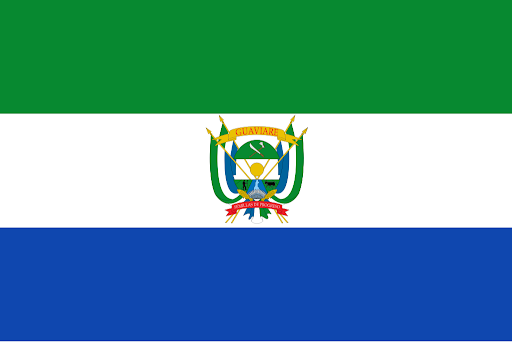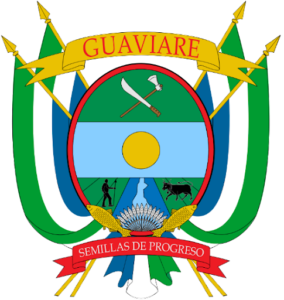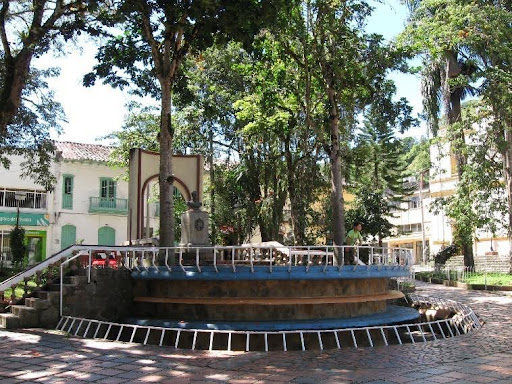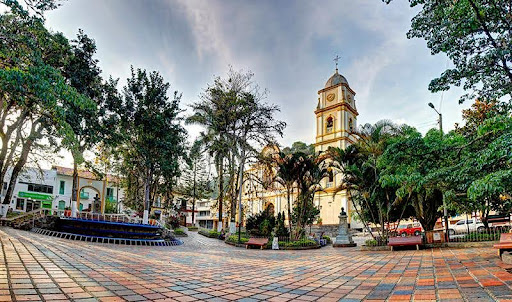MIRAFLORES
Department

Flag of the city
The written support of the flag is as follows, Green: represents the forest wealth of the municipality. White: symbolizes peace. Blue: represents the wealth of its waters. Sun: reflects the light of hope in the development of the municipality

Seal of the city
The city does not have a specific seal; however, below is the seal of its department

Slogan of the city
The city does not have a specific slogan but the motto of its department is “Seed of Progress” which is emphasize the need for growth and development for every of its municipalities and residents.
History

Miraflores, a town and municipality in the Guaviare Department of Colombia, has a relatively recent history. The municipality was officially established on February 8, 1990, as part of the broader administrative changes in the region. This transformation occurred when the Comisaria of Guaviare was elevated to the status of the Department of Guaviare, and Miraflores emerged as one of its constituent municipalities. During its early years, Miraflores faced challenges related to security. In August 1998, a Colombian National Police Base in the area fell victim to an attack by the Revolutionary Armed Forces of Colombia (FARC) guerrillas. However, the base was subsequently rebuilt and reoccupied in February 2004, reflecting the resilience and determination of the local community and authorities. The town’s population was approximately 14,381 in 1993, highlighting its relatively modest size. Miraflores owes its existence to a group of colonizers who ventured into the region during the 20th century, contributing to the settlement and establishment of the town. Miraflores, with its foundation as a municipality in 1990, represents a chapter in the evolving history of the Guaviare Department. The community’s growth, challenges, and resilience are integral to the broader narrative of development and change in this part of Colombia.
Geography of the city
Miraflores, situated in the Guaviare Department of Colombia, is defined by its geographic coordinates at approximately N 01°22’14” latitude and W 71°57’41” longitude, with an elevation of 180 meters above sea level. Positioned about 150 km from the departmental capital, San Jose del Guaviare, Miraflores lies near the Itilla and Unilla Rivers and is enveloped by the Vaupés River and various water currents. The town’s terrain is primarily flat or slightly undulated, covered by the dense jungle typical of the Amazon basin, contributing to its lush and diverse ecological landscape. Miraflores experiences a warm and highly humid climate, maintaining an average temperature of 28 °C throughout the year. These geographic features, coupled with its proximity to rivers and tropical climate, underline Miraflores’ integral place within the Amazon rainforest ecosystem.

Population
Total 5,007 (Census 2018)
One photo representative of the city

Etymology
The etymology of the name “Miraflores” has Spanish origins and translates to “look at the flowers” or “admire the flowers” in English. The term is a combination of two Spanish words: “mirar,” meaning “to look,” and “flores,” meaning “flowers.” Therefore, Miraflores is a toponym that reflects an appreciation for the natural beauty of flowers or the act of gazing at floral landscapes. This name is commonly used for various locations in Spanish-speaking countries, and it often reflects the scenic and picturesque nature of the places it designates. The choice of the name may be influenced by the presence of abundant flora, gardens, or visually appealing landscapes in the region. The use of “Miraflores” underscores a connection to nature and an invitation to appreciate the beauty of the surroundings, which could be particularly fitting for a town surrounded by the lush jungles of the Amazon basin.
What the city is known or famous for

Miraflores, like many towns in the Amazon basin, could be known for its natural beauty, lush jungles, and rich biodiversity. The town’s location near rivers and within the Amazon rainforest may make it appealing for those interested in exploring the diverse flora and fauna of the region. The town might have cultural significance, with a history and heritage shaped by indigenous communities or the influence of colonizers. Cultural events, traditions, and local customs could contribute to the town’s identity. Given the historical context of the region, Miraflores may have archaeological sites or artifacts that provide insights into the pre-Columbian cultures that once inhabited the area. With its proximity to rivers, flat terrain, and jungle environment, Miraflores might be recognized for ecotourism opportunities. Visitors may be drawn to activities such as hiking, birdwatching, and exploring the natural landscapes. The town’s history might include instances of resilience and overcoming challenges, such as the rebuilding of the Colombian National Police Base after an attack in 1998. These aspects can contribute to the town’s character and story.
